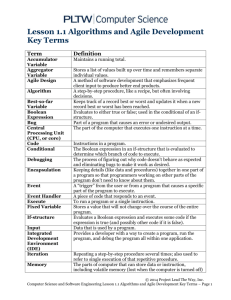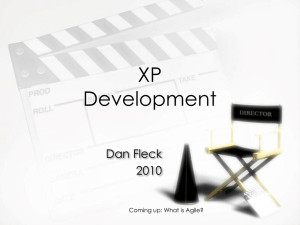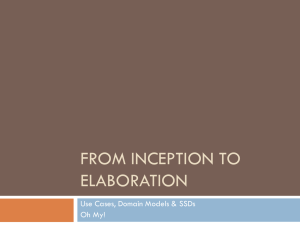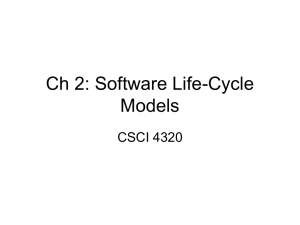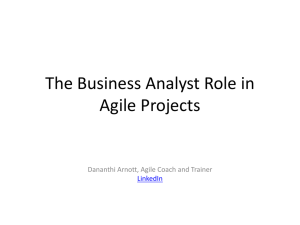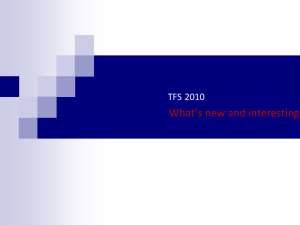Release Planning
advertisement
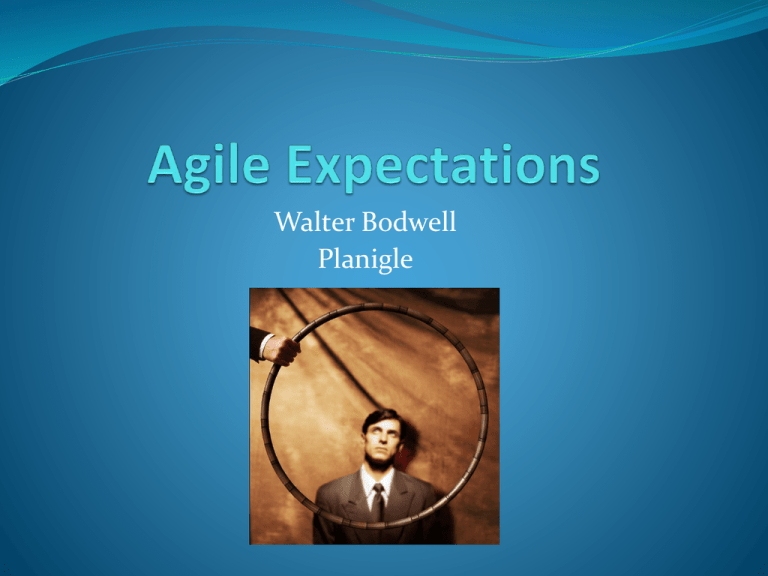
Walter Bodwell Planigle An Introduction – Walter Bodwell First did agile at a startup in 1999 Got acquired by BMC in 2000 and spent the next 8 years doing agile at scale Now providing consulting, tools and training to help teams get the most out of agile at Planigle 5 Levels of Planning Product Vision Product Roadmap Release Plan Iteration Plan Daily Standup Adapted from “5 Levels of Agile Planning” by Hubert Smits Product Vision What are you trying to accomplish? How is that going to benefit the business? Product Vision Product Roadmap Release Plan Iteration Plan Daily Standup Product Roadmap High level themes for the next few releases Shows progress towards strategy Lots of “wiggle room” Product Vision Product Roadmap Release Plan Iteration Plan Daily Standup Release Plan Go into next level of detail towards themes Get everyone on the same page Understand what you will likely achieve Balance load between the teams A projection, not a commitment Product Vision Product Roadmap Release Plan Iteration Plan Daily Standup Timing Release planning should occur just before the teams start on the release If teams are just forming, delay until after the teams have done 2 or 3 iterations (so that they understand their velocity) If the release is long (over 4-6 months), release planning might occur multiple times to resynch High fidelity for close items Low fidelity for items further out Preparing for Release Planning Set themes Prepare the backlog Identify teams Divvy stories up Understand the issues Size the stories Define what done is Identify key dates Set Themes / Investment Areas What are the areas we’re going to invest in for this release? Themes give you room to be flexible We know we’re going to do something We’ll decide as we go how much Themes are a great way to communicate the focus of the release without prematurely committing you to details The Backlog Rank order things Each should meet I.N.V.E.S.T. criteria Size will vary based on how far out Why Prioritize? Identifying Teams It is preferable to have each team have the ability to complete its work by itself In other words, instead of a team per component, have teams with members who have knowledge of each component that will need to change to deliver something Don’t change the teams frequently Components or Features? Component teams provide expertise But limit the ability to attack the highest priorities And require more coordination (complexity) Divvying Things Up Your goal is to divvy things up so that teams are working on items of around the same priority If each team able to get 3 blocks in the release, the highlighted stories won’t make it Bad By better distributing stories amongst the teams, look which stories won’t make it Good Dependencies Approaches (go with the first one you can): Structure the teams so that a single team can solve the problem end to end Do the work within the same iteration Implement the service and then use it Stub out the service and implement it later Make sure the dependent teams (including external ones) are represented at release planning Understanding the Issues Keep to the minimal responsible amount of doc No more than you need at any point in time Just enough to understand dependencies and mitigate risks The right size for the problem Do you need this now? If not, try to reduce or eliminate it Agile Architecture Just enough Refactor as you go Estimating Identify a medium sized story that is well understood; call it a 5 Now estimate other stories relative to that Is it about the same, ½ as difficult, twice as difficult? Use Fibonacci numbers: 1, 2, 3, 5, 8, 13, 21 If bigger than that or if too hard to estimate, split the story Why Story Points? Time estimates Vary by person Encourage padding Tend to grow stale Story points More consistent from person to person Not a commitment to time frame Don’t change as much Easier to estimate relative size Velocity Now that stories have sizes, you can track how many points you typically get done in an iteration You can now use this to predict future completion rates Story Points Across Teams To get teams in the same ballpark, pick a baseline story Each team should understand the complexity Choose a medium size story Call it a ‘5’ All other stories are relative to it Don’t compare velocity Used by a team to evaluate itself If others use it for evaluation, it will be gamed and become useless Definition of Done Define what “Done” means for your team Make “Done” more stringent over time Definition of Done evolves as you do Key Dates How many iterations? When do they start / stop? Which iterations (if any) are hardening? Any other dates to be mindful of? Release Planning Kick off / Overview Break Out Sessions Review Results Attendees Product Owners ScrumMasters Architects / Leads QA Writers Other Stakeholders This is the best time to travel! Release Planning Deliverables Plan for each Iteration Assumptions Dependencies Risks Philosophies Simple Is Better Allows for better coverage across features Prevent unnecessary complexity If you go too simple, it will remain unused until you follow up with the market demanded features next release If you go too complex, it is very difficult to identify and remove the unnecessary complexity Leave Room To Be Agile No more than 70% of our time should be allocated to committed features Release Planning Wrap Up Go through each iteration for each team Are things synched up across teams? Are you attacking the most important stories? Does the team believe in the results? Is This Reasonable? Everyone agrees the release is doable Use disagreement and uneasiness in team members to drive out hidden risks, tasks, and issues Drive agreement with a fist to five Absolutely, no question I think this is good and will make it happen I can support this I’m uneasy about this and think we need to talk it out some more Let’s continue discussing this idea in the parking lot After The Meeting Capture the results in your tool of choice Update after each iteration Notify of major changes to the plan Communicating the Future Themes give you room to be flexible If a customer is asking about a particular feature, you can get into a discussion of priorities Demos are a potential opportunity to get a customer involved Smaller, incremental releases generate feedback on what to dig into in more detail Prioritization Doesn’t Stop The product owner re-prioritizes after each iteration We’ve learned more about the business Let’s take advantage of that The further down the list something is, the less defined it will be and the less important it is to prioritize precisely Questions? Walter Bodwell Planigle wbodwell@planigle.com Twitter: @wbodwell www.planigle.com www.walterbodwell.com

